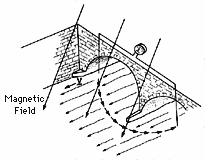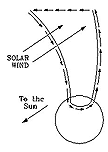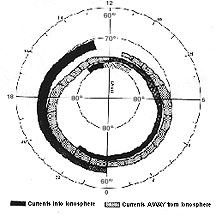|
[an error occurred while processing this directive]
#25. Electric Currents from Space
|
(Files in red–history) |
This limited extent suggested that the currents which disturbed the field flowed somewhere nearby, probably near the auroral arcs. The Norwegian Kristian Birkeland, who carefully observed auroral disturbances around the turn of the century, concluded that those currents flowed parallel to the ground, along the auroral formation.
Any electric current, however, must flow in a closed circuit, and since it seemed to be caused (like that of the aurora) by processes taking place in distant space, Birkeland proposed that it came down from space at one end of the arc and returned to space at the other end. The drawing here illustrates the idea and was taken from Birkeland's 1903 report on his expeditions to the auroral zone:
When a bright aurora is seen in the auroral zone, a strong magnetic disturbance is usually also observed there. The disturbing magnetic field can be much stronger than that of a magnetic storm but it is strictly local, fading away quickly as one moves equatorward.
|
|
This limited extent suggested that the currents which disturbed the field flowed
somewhere nearby, probably near the auroral arcs. The Norwegian Kristian Birkeland, who carefully observed auroral disturbances around the turn of the
century, concluded that those currents flowed parallel to the ground, along the auroral formation.
Any electric current, however, must flow in a closed circuit, and since it seemed to be caused (like that of the aurora) by processes taking place in distant space, Birkeland proposed that it came down from space at one end of the arc and returned to space at the other end. The drawing here illustrates the idea and was taken from Birkeland's 1903 report on his expeditions to the auroral zone:
In all those cases, some electrically conducting fluid appears to be moving
through a magnetic field--plasma in space and on the Sun, molten iron (probably)
in the Earth's core. It can then be shown from the principles of physics that if a closed electric circuit exists, parts of which are moving through a magnetic field while other parts are not, an electric current will arise (additional conditions must
also be satisfied). The electric energy needed to drive the current is taken from the motion, which is slowed down.
Long ago, a machine that generated electricity was named "dynamo" (today's preferred term is "generator"). In analogy, a set-up where a conducting fluid flows through a magnetic field and creates an electric current in the above fashion, is called a "fluid dynamo," or when a fluid process is clearly implied, simply "dynamo".
The idea was sound, but the current was too weak to be measured by him. Faraday nevertheless speculated that the aurora (which he believed to be an electric phenomenon) might be powered in a similar way by the Gulf Stream flowing to the north-east through the Atlantic Ocean, beginning just offshore from the US. Of course, what Faraday forgot here was that to connect the ocean to the aurora, the current would have to cross the lower atmosphere, which is an excellent insulator and would block its flow. An interesting dynamo of this type exists between the planet Jupiter and its innermost big moon Io (click for details). The space shuttle can also generate electric power that way (at the expense of its orbital energy), using a long wire dangling from it into space. Such a space tether experiment was conducted aboard the space shuttle Columbia on 25 February, 1996, ending unexpectedly when the tether suddenly broke. Sir Joseph Larmor in England first proposed in 1919 that dynamos consisting entirely of fluids might explain the creation of sunspot magnetic fields. His idea was that as solar plasma flowed through magnetic fields, dynamo effects produced the very same currents which also created those magnetic fields. Because this is a process which "lifts itself by its own bootstraps" (the magnetic fields needed by the dynamo are produced by the electric currents which are its output), it must build up gradually, starting from some "seed" magnetic field of a different source. Such a "dynamo mechanism" was also believed to be the source of the magnetic field arising inside the Earth's molten core. It is impossible to observe that region directly, but in 1964 Stanislaw Braginsky, in Russia, mathematically demonstrated a possible class of such "dynamos." The slow decade-by-decade variation of the Earth's field probably comes from slow changes in the flow patterns of the core - not, as Halley once proposed, from magnetized spherical layers, one inside the other, all rotating differently.
If the bundle of open lines maps to the region inside the auroral oval, it can be shown that the "dynamo currents" from the above process flow earthward on the morning side of the magnetic pole and spaceward on the evening side. One might guess that the circuit would be completed by connecting the two flows across the polar ionosphere, from the morning side, to the evening side (drawing below; the situation is more complicated, however, because the flow also deforms the field lines).
But that wasn't all. Equatorward of each current sheet, Triad noted a parallel sheet almost as intense, flowing in the opposite direction: those field lines were no longer open, but closed inside the magnetosphere. It thus seemed that most of the electric current coming down from space (about 80%) did not choose to close through the ionosphere across the magnetic poles. Rather, it found an alternate way: it flowed in the ionosphere a few hundred miles equatorward and then headed out again to space, where the currents (presumably) found an easier path.
A 1976 study by Takesi Iijima and Tom Potemra used Triad data to map the average "footprints" of these sheets in the polar ionosphere, including their intricate overlap at midnight. Their result is plotted below: the map is centered at the northern magnetic pole (though southern data were combined to produce this graph), midnight is at the bottom, and noon (where some minor additional currents exist) is at the top. Dark shading indicates currents flowing towards Earth, light shading, currents flowing outward into space.
Questions from Users: *** 25 How can steady magnetic fields induce electric currents? |
Next Stop: #25A. Currents from Space--History
- Back to the Index Page
Timeline Expanded timeline Glossary
Author and Curator: Dr. David P. Stern
Mail to Dr.Stern: education("at" symbol)phy6.org
Co-author: Dr. Mauricio Peredo
Spanish translation by J. Méndez
Reformatted 3-13-2006




